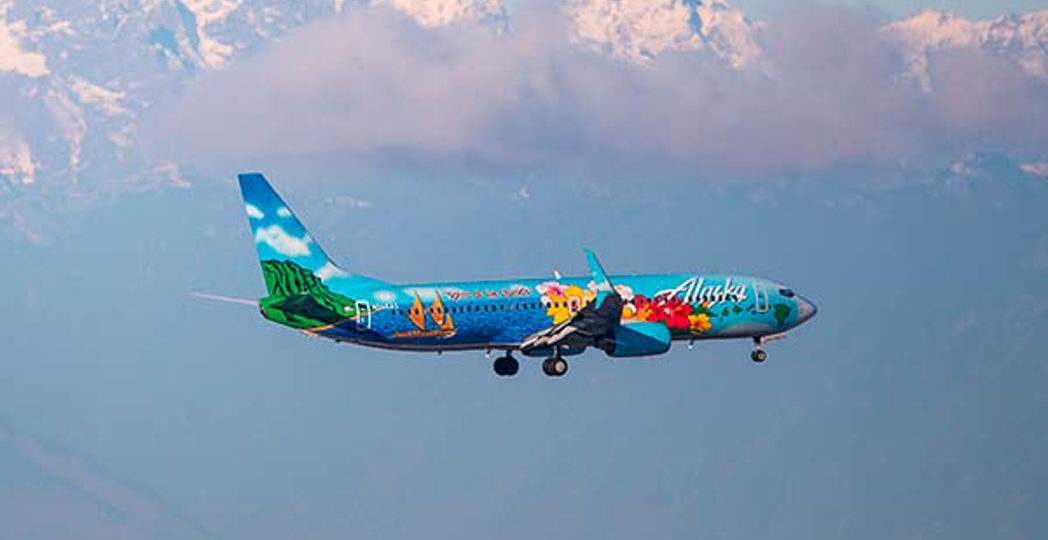NEO Biz: New Routes Coming to Cleveland
by Jill Sell | Feb. 1, 2022 | 5:00 AM

When Alaska Airlines completes its first daily, nonstop flight connecting Cleveland and Seattle on June 16, 2022, it will mark the airline’s 100th destination.
The flight better be on time, because the airline will be serving Miami for the first time in a similar way about two hours later. If Cleveland is the 100th, it would be kind of nice. But, it’s not just about bragging rights. Alaska Airlines’ economic impact on Cleveland-Hopkins International Airport is projected to be $30 million.
It is the country’s fifth largest airline based on passenger traffic.
“And it’s not just the flight,” says Robert Kennedy, director of Port Control for the city of Cleveland Port Control. “This opens up greater opportunities for people in Seattle to do business here and for people here to do business in Seattle and points beyond. That happens every time you open a new air route.”
Brett Catlin, Alaska Airlines’ vice president of network and alliances, notes that the airline had been looking at Cleveland for almost six years. The city “was a hole in our network and one we wanted to fill, but the timing and environment was never quite right,” Catlin says.
“When you open a new station like Cleveland, there are significant startup costs. And, there is also the risk of not knowing if the market is going to work. We don’t want to open and then close a year later,” says Catlin, adding that the nonstop service also opens service to a number of destinations in the Pacific Northwest and Alaska. “We take our destinations very seriously. We understand the power that air service has and what it means to a city like Cleveland. We want to be sure we will be there for the long haul.”
Having a nonstop air link matters to companies thinking about expansion, and in Cleveland, that also means sharing its IT, health and manufacturing assets with new markets. It’s also important to families who find it easier to travel to see loved ones, Catlin says.
“Seattle was our No. 1 underserved market,” says Kennedy, adding that the airport looked for an airline that had both the network and the aircraft to get the goal off the ground. “Alaska Airlines had both.”
Air service experts agree it is easier to get an airline to expand in a market than to add a new city to its log. Both Kennedy and Catlin give credit to the airport’s partners, the city of Cleveland, Greater Cleveland Partnership, Team NEO and Destination Cleveland, for encouraging Alaska Airlines to land here.
The JobsOhio Air Service Restoration Program was established in 2020 to allow Ohio’s commercial airports to work with public and private partnerships to restore air service for economic development. It also gets a thumbs up for its role in snagging Alaska Airlines, according to Kennedy and Catlin.
“Everyone lost their air service because of the pandemic,” says Terry Slaybaugh, vice president for sites and infrastructure with JobsOhio. “At one point in May 2020, only about 5% of aircraft was flying in the U.S. But we also knew it was an opportunity to level the playing field. We do compete against Pittsburgh, Indianapolis and other cities.
“When airlines have available equipment, they have the opportunity to put that equipment in 400 cities. Cleveland and Columbus are in a group of about 30 to 40 cities of similar size that can benefit. It’s a tough competition. But, we felt that a program like this one gave Ohio a leg up.”
In the Midwest, only Pennsylvania lost more air service than Ohio because of the pandemic, according to JobsOhio.
Catlin says the partners involved and JobsOhio “not only helped with logistics, but stepped up with the financials to give us the confidence.”
JobsOhio is a private, nonprofit corporation focused on job creation and investment throughout the state.
“JobsOhio allowed us to move forward without a little more risk than we might have had otherwise,” says Catlin.
Breeze Airways launched service for Akron-Canton Airport in June last year with destinations to New Orleans, Tampa and Charleston, South Carolina. JobsOhio also provided some wind under Breeze’s wings to get off of the ground in Ohio.
“Breeze will have a fantastic impact on Akron. We’ll also see more activity from Breeze in the first quarter of 2022 as it continues to get new aircrafts. They have 16 airplanes now, 13 they fly and three kept as backup,” says Slaybaugh, a former airport manager. “At the end of 2022, Breeze will have 30 aircrafts and will expand in markets where they launched service in 2021. What I really like about Breeze is that it introduced new markets. Even Columbus didn’t have service to Charleston.”
Other airlines are taxiing toward contributing to the airport’s and the city’s economic development. According to Erik Hoffman, director of communications for Spirit Airlines, the air carrier has plans to add a second gate at the airport’s A concourse and will also expand office space. A new daily Cleveland-to-Miami route was launched in December. Also that month, United Airlines restarted service from Cleveland to Las Vegas and Phoenix, which will run mid-December though late March.
Kennedy appreciates an air service result called the stimulation factor. He knows the idea has been beneficial for Cleveland and will continue to be. An example, he says, has been flights out of Cleveland to Iceland. When a service is initiated, weekly passenger lists may not be that impressive.
“But then people say, ‘If I can get on a plane in Cleveland and go to Iceland, I’ll go to Iceland.’ They take advantage of that opportunity,” says Kennedy.
All of this is good news for Cleveland, Northeast Ohio and the state. According to JobsOhio, the state’s airports contribute more than $17 billion per year to Ohio. In addition, airport projects online at the end of 2021 added up to 14 new routes for a potential economic impact of $268 million.
Still, there is some rough air ahead for Cleveland-Hopkins International Airport and air service facilities across the country. Kennedy says the U.S. needs domestic airline pilots to cover its shortage. Also, with omicron and other potential COVID-19 variants rearing their ugly heads, nothing is certain about air travel. Cleveland’s airport also lost 3,200 jobs on its campus in 2020, but Kennedy is fighting to get workers rehired or new hires on board.
Kennedy is optimistic about the future of Cleveland’s airport, however, and Cleveland’s private and public leaders are hoping his head is not in the clouds.
“I love it when I can get an air carrier to come here and see what we have to offer,” says Kennedy. “The numbers are the numbers, and they are important data. But, to come here and feel the energy and to feel what you can’t put in a table or graph, and to get the reception from the community here is something you have to experience. Cleveland always surprises everyone. You can taste the opportunity here.”
The Cleveland-Hopkins International Master Plan calls for airfield improvement, modernizing the terminal, developing green initiatives and creating conveniences for customers. The plan calls for taking down some older outdated buildings and facilities “that were designed, opened and operating when propeller aircraft was the dominant aircraft,” according to Kennedy. Modernizing the airport is necessary to be competitive, safer and more secure, according to the master plan.
“Once you see the airport grow, you see the community grow,” says John Hogan, the airport’s deputy chief, marketing and air service development.
Kennedy also says the airlines’ passenger mix has changed. Numbers of business travelers are not quite up to pre-COVID-19 times. Leisure passengers increased because of “the itch to travel” and the desire to connect more with family.
Cleveland-Hopkins International Airport was the first municipally owned airport in the U.S. and opened in 1925.
The airport — the state’s busiest airport — must also make room for larger aircrafts. In years past, a plane capable of carrying 76 passengers was the norm. Now, 112 passengers are common, with “a lot carrying 230 passengers every day,” says Kennedy.
In 2019, the airport had a passenger count of 10 million. With the pandemic in 2020, it was 4.1 million. It was projected that 5.2 million passengers would use the airport in 2021, but late in the year, that number was approximately 7.3 million. Kennedy says the number is above the national average of recovery.
But, with more passengers comes more strain on what, in airport jargon, is called “the front of the house,” including baggage claim, ticket counters, roadways, parking, etc. Of course, travelers who spend some time in Cleveland also contribute to the economy by visiting restaurants, retail stores, hotels, entertainment venues, cultural institutions, conventions and sporting events. It’s a complex situation that successful airports around the world know how to handle.
“We can’t get ourselves into trouble with the FAA or TSA because that erodes the confidence in the airport. “Over the next 25 years, we will welcome a quarter of a billion people” says Kennedy. “This facility has to be ready to accommodate them and give them a comfortable experience. We are that handshake ‘hello’ and that wave ‘goodbye’ for every traveler who comes through this airport.”
Trending
-
1
-
2
-
3
-
4
-
5










